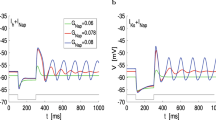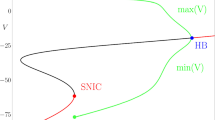Abstract
We investigate the role of adaptation in a neural field model, composed of ON and OFF cells, with delayed all-to-all recurrent connections. As external spatially profiled inputs drive the network, ON cells receive inputs directly, while OFF cells receive an inverted image of the original signals. Via global and delayed inhibitory connections, these signals can cause the system to enter states of sustained oscillatory activity. We perform a bifurcation analysis of our model to elucidate how neural adaptation influences the ability of the network to exhibit oscillatory activity. We show that slow adaptation encourages input-induced rhythmic states by decreasing the Andronov–Hopf bifurcation threshold. We further determine how the feedback and adaptation together shape the resonant properties of the ON and OFF cell network and how this affects the response to time-periodic input. By introducing an additional frequency in the system, adaptation alters the resonance frequency by shifting the peaks where the response is maximal. We support these results with numerical experiments of the neural field model. Although developed in the context of the circuitry of the electric sense, these results are applicable to any network of spontaneously firing cells with global inhibitory feedback to themselves, in which a fraction of these cells receive external input directly, while the remaining ones receive an inverted version of this input via feedforward di-synaptic inhibition. Thus the results are relevant beyond the many sensory systems where ON and OFF cells are usually identified, and provide the backbone for understanding dynamical network effects of lateral connections and various forms of ON/OFF responses.








Similar content being viewed by others
References
Bastian, J., Chacron, M. J., & Maler, L. (2002). Receptive field organization determines pyramidal cell stimulus-encoding capability and spatial stimulus selectivity. Journal of Neuroscience, 22, 4577–4590.
Benda, J., Bethge, M., Hennig, M., Pawelzik, K., & Herz, A. V. M. (2001). Spike-frequency adaptation: Phenomenological model and experimental tests. Neurocomputing, 38–40, 105–110.
Benda, J., & Herz, A. (2003). A universal model for spike-frequency adaptation. Neural Computation, 15, 2523–2564.
Benda, J., Longtin, A., & Maler, L. (2005). Spike-frequency adaptation separates transient communication signals from background oscillations. The Journal of Neuroscience, 25, 2312–2321.
Benda, J., Longtin, A., & Maler, L. (2006). A synchronization-desynchronization code for natural communication signals. Neuron, 52, 347–358.
Benda, J., Maler, L., & Longtin, A. (2010). Linear versus nonlinear signal transmission in integrate-and-fire models with adaptation currents or dynamic thresholds. Journal of Neurophysiology. In press.
Berman, N. J., & Maler, L. (1998). Distal versus proximal inhibitory shaping of feedback excitation in the electrosensory lateral line lobe: Implications for sensory filtering. Journal of Neurophysiology, 80, 3214–3232.
Berman, N. J., & Maler, L. (1999). Neural architecture of the electrosensory lateral line lobe: Adaptations for coincidence detection, a sensory searchlight and frequency-dependent adaptive filtering. Journal of Experimental Biology, 202, 1243.
Blomquist, P., Wyller, J., & Einevoll, G. T. (2005). Localized activity patterns in two-population neuronal networks. Physica D, 206, 180.
Borgers, C., Epstein, S., & Kopell, N. J. (2008). Gamma oscillations mediate stimulus competition and attentional selection in a cortical network model. Proceedings of the National Academy of Sciences of the United States of America, 105, 18023.
Borgers, C., & Kopell, N. (2003). Synchronization in networks of excitatory and inhibitory neurons with sparse, random connectivity. Neural Computation, 15, 509–538.
Brandt, S. F., & Wessel, R. (2007). Winner-take-all selection in a neural system with delayed feedback. Biological Cybernetics, 97, 221–228.
Chacron, M., et al. (2005). Delayed excitatory and inhibitory feedback shape neural information transmission. Physics Review E, 72, 051917.
Chacron, M., Longtin, A., & Maler, L. (2005). Feedback and feedforward control of frequency tuning to naturalistic stimuli. Journal of Neuroscience, 25, 5521–5532.
Crook, S., Ermentrout, G. B., & Bower, J. M. (1998). Spike-frequency adaptation affects the synchronization properties of cortical oscillatiors. Neural Computation, 10, 837–854.
Curtu, R., & Ermentrout, B. (2004). Pattern formation in a network of excitatory and inhibitory cells with adaptation. SIAM Journal of Applied Dynamical Systems, 3, 191–231.
Dhamala, M., Jirsa, V. K., & Ding, M. D. (2004). Enhancement of neural synchrony by time delay. Physical Review Letters, 92, 074104.
Doiron, B., Chacron, M. J., Maler, L., Longtin, A., & Bastian, J. (2003). Inhibitory feedback required for network oscillatory response to communication but not prey stimuli. Nature, 421, 539.
Doiron, B., Lindner, B., Longtin, A., Bastian, J., & Maler, L. (2004). Oscillatory activity in electrosensory neurons increases with the spatial correlation of the stochastic input stimulus. Physical Review Letters, 93, 4.
Ermentrout, B., Pascal, M., & Gutkin, B. (2001). The effects of spike frequency adaptation and negative feedback on the synchronization of neural oscillators. Neural Computation, 13, 1285–1310.
Folias, S. E., & Bressloff, P. (2005). Breathers in two-dimensional neural media. Physical Review Letters, 95, 208107.
Gabbiani, F. (1996). Coding of time-varying signals in spike trains of linear and half-wave rectifying neurons. Network Computing in Neural System, 7, 61–85.
Gabbiani, F., & Krapp, H. G. (2006). Spike-frequency adaptation and intrinsic properties of an identified, looming-sensitive neuron. Journal of Neurophysiology, 96, 2951–2962.
Gollisch, T., & Herz, A. V. M. (2004). Input-driven components of spike-frequency adaptation can be unmasked in vivo. Journal of Neuroscience, 24, 7435–7444.
Gollisch, T., & Meister, M. (2008). Modeling convergent on and off pathways in the early visual system. Biological Cybernetics, 99, 263–278.
Golomb, D., & Ermentrout, G. B. (2001). Bistability in pulse propagation in networks of excitatory and inhibitory populations. Physical Review Letters, 86, 4179.
Gray, C. M., & Singer, W. (1989). Stimulus-specific neuronal oscillations in orientation columns of cat visual cortex. Proceedings of the National Academy of Sciences of the United States of America, 86, 1698–1702.
Kandel, E. R., & Schwarz, J. H. (1983). Principles of neural science. New York: Elsevier.
Kilpatrick, Z. P., & Bressloff, P. C. (2010). Effects of synaptic depression and adaptation on spatiotemporal dynamics of an excitatory neuronal network. Physica D, 239, 547–560.
Kim, K. J., & Rieke, F. (2001). Temporal contrast adaptation in the input and output signals of salamander retinal ganglion cells. Journal of Neuroscience, 21, 287–299.
Kim, K. J., & Rieke, F. (2003). Slow Na+ inactivation and variance adaptation in salamander retinal ganglion cells. Journal of Neuroscience, 23, 1506–1516.
Krahe, R., Bastian, J., & Chacron, M. J. (2008). Temporal processing across multiple topographic maps in the electrosensory system. Journal of Neurophysiology, 100, 852–867.
Laing, C., & Coombes, S. (2006). The importance of different timings of excitatory and inhibitory pathways in neural field models. Network, 17, 151.
Lefebvre, J., Longtin, A., & LeBlanc, V. G. (2009). Dynamics of driven recurrent networks of on and off cells. Physics Review E, 80, 041912.
Lefebvre, J., Longtin, A., & Leblanc, V. G. (2010). Oscillatory response in a sensory network of on and off cells with instantaneous and delayed recurrent connections. Philosophical Transactions of the Royal Society A: Mathematical, Physical and Engineering Sciences, 368, 455–467.
Liang, Z., & Freed, M. A. (2010). The on pathway rectifies the off pathway of the mammalian retina. Journal of Neuroscience, 30, 5533–5543.
Lindner, B., Doiron, B., & Longtin, A. (2005). Theory of oscillatory firing induced by spatially correlated noise and delayed inhibitory feedback. Physics Review E, 72, 061919.
Liu, Y. H., & Wang, X. J. (2001). Spike-frequency adaptation of a generalized leaky integrate-and-fire model neuron. Journal of Computational Neuroscience, 10, 25–45.
Ly, C., & Ermentrout, G. B. (2010). Analysis of recurrent networks of pulse-coupled noisy neural oscillators. SIAM Journal of Applied Dynamical Systems, 9, 113–137.
Maler, L., Sas, E., Johnston, S., & Ellis, W. (1991). An atlas of the brain of the electric fish Apteronotus leptorhynchus. Journal of Chemical Neuroanatomy, 4, 1–38.
Marinazzo, D., Kappen, H. J., & Gielen, S. C. A. M. (2007). Input-driven oscillations in networks with excitatory and inhibitory neurons with dynamic synapses. Neural Computation, 19, 1739–1765.
Mathieson, W. B., & Maler, L. (1988). Morphological and electrophysiological properties of a novel in vitro preparation: The electrosensory lateral line lobe brain slice. Journal of Comparative Physiology A, 163, 489–506.
Mehaffey, W. H., Maler, L., & Turner, R. W. (2008). Intrinsic frequency tuning in ELL pyramidal cells varies across electrosensory maps. Journal of Neurophysiology, 99, 2641–2655.
Pauluis, Q. (2000). Statistical signs of common inhibitory feedback with delay. Neural Computation, 12, 2513–2518.
Pauluis, Q., Baker, S. N., & Olivier, E. (1999). Emergent oscillations in a realistic network: The role of inhibition and the effect of the spatiotemporal distribution of the input. Journal of Computatational Neuroscience, 6, 27–48.
Prescott, S. A., et al. (2006). Nonlinear interaction between shunting and adaptation controls a switch between integration and coincidence detection in pyramidal neurons. Journal of Neuroscience, 26, 9084–9097.
Prescott, S. A., & Sejnowski, T. J. (2008). Spike-rate coding and spike-time coding are affected oppositely by different adaptation mechanisms. Journal of Neuroscience, 28, 13649–13661.
Robin, D. A., & Royer, F. L. (1987). Auditory temporal processing: Two-tone flutter fusion and a model of temporal integration. Journal of the Acoustical Society of America, 82, 1207.
Sah, P., & Davies, P. (2000). Calcium-activated potassium currents in mammalian neurons. Clinical and Experimental Pharmacology and Physiology, 27, 657–663.
Scholl, B., Gao, X., & Wehr, M. (2010). Nonoverlapping sets of synapses drive on responses and off responses in auditory cortex. Neuron, 65, 412–421.
Sobel, E., & Tank, D. W. (1994). In vivo Ca2 + dynamics in a cricket auditory neuron: An example of chemical computation. Science, 263, 823–826.
Storm, J. F. (1990). Potassium currents in hippocampal pyramidal cells. Progress in Brain Research, 83, 161–187.
van Vreeswijk, C., & Hansel, D. (2001). Patterns of synchrony in neural networks with spike adaptation. Neural Computation, 13, 959–992.
Wang, X. J., Liu, Y., Sanchez-Vives, M. V., & McCormick, D. A. (2003). Adaptation and temporal decorrelation by single neurons in the primary visual cortex. Journal of Neurophysiology, 89, 3279–3293.
Whittington, M. A., Traub, R. D., & Jeffery’s, J. G. R. (1995). Synchronized oscillations in interneuron networks driven by metabotropic glutamate receptor activation. Nature, 373, 612–615.
Wilson, H. R., & Cowan, J. D. (1972). Excitatory and inhibitory interactions in localized populations of model neurons. Biophysical Journal, 12:1–24.
Xu, Z., Payne, J. R., & Nelson, M. E. (1996). Logarythmic time course of sensory adaptation in electrosensory afferent nerve fibers in a weakly electric fish. Journal of Neurophysiology, 76, 2020–2032.
Author information
Authors and Affiliations
Corresponding author
Additional information
Action Editor: Brent Doiron
Rights and permissions
About this article
Cite this article
Lefebvre, J., Longtin, A. & LeBlanc, V.G. Neural adaptation facilitates oscillatory responses to static inputs in a recurrent network of ON and OFF cells. J Comput Neurosci 31, 73–86 (2011). https://doi.org/10.1007/s10827-010-0298-4
Received:
Revised:
Accepted:
Published:
Issue Date:
DOI: https://doi.org/10.1007/s10827-010-0298-4




